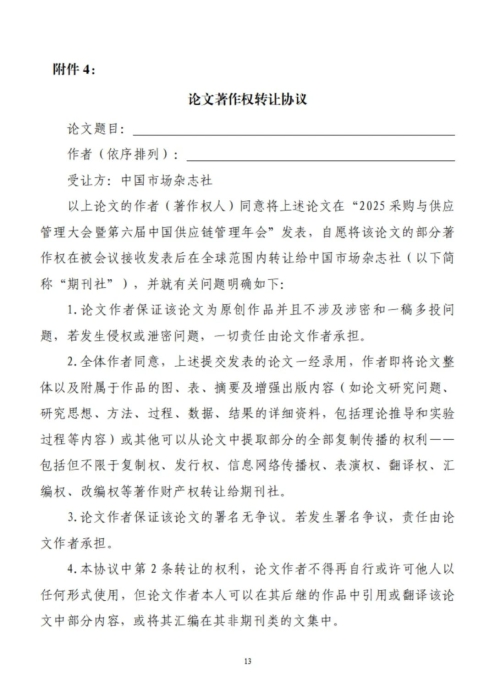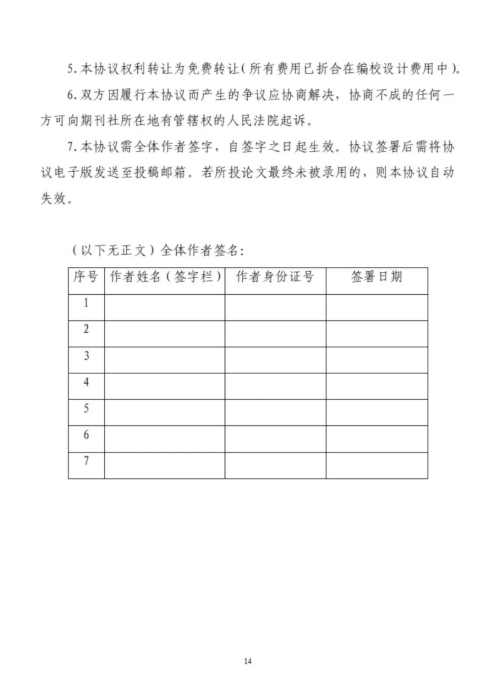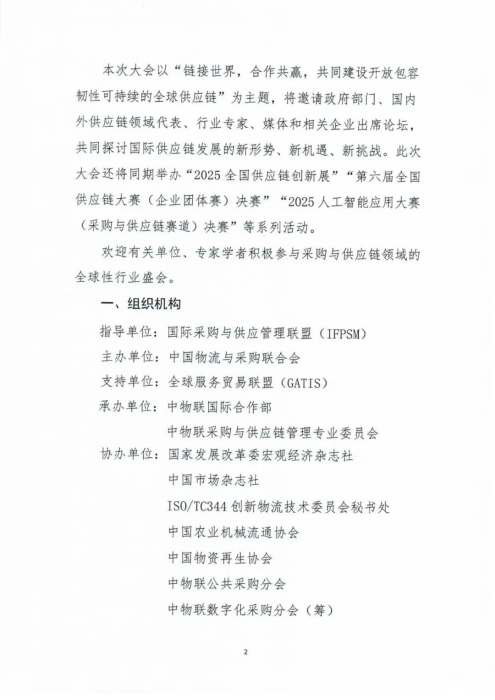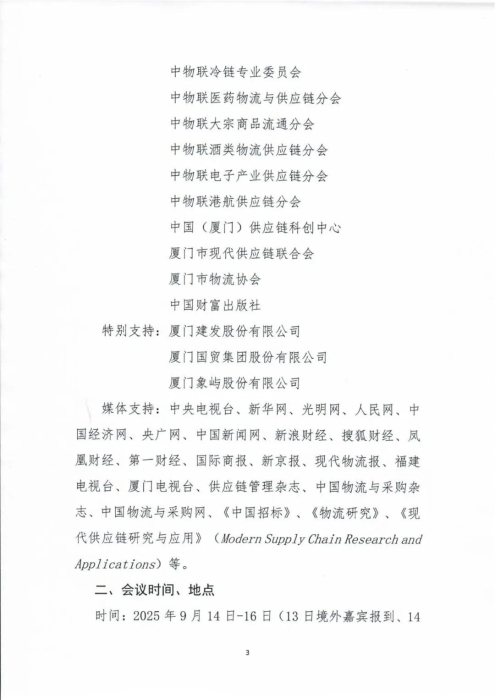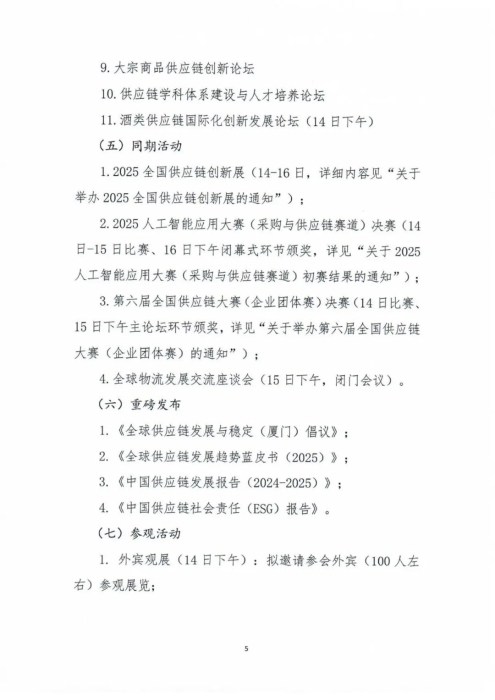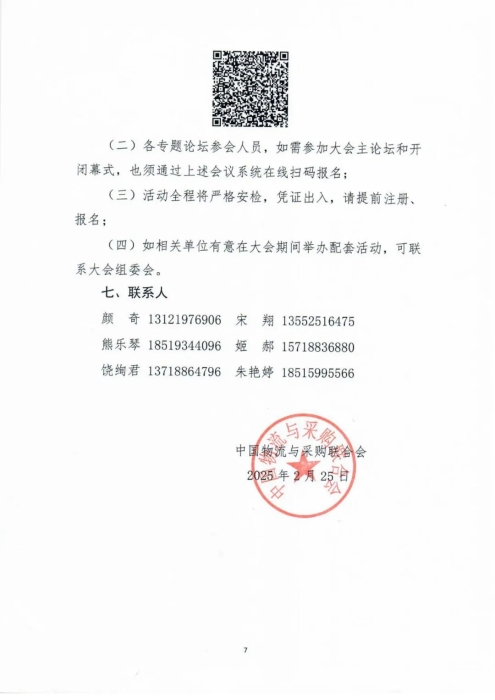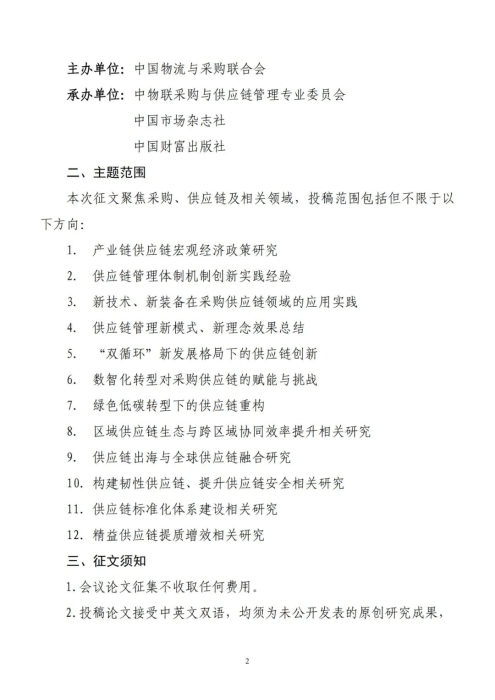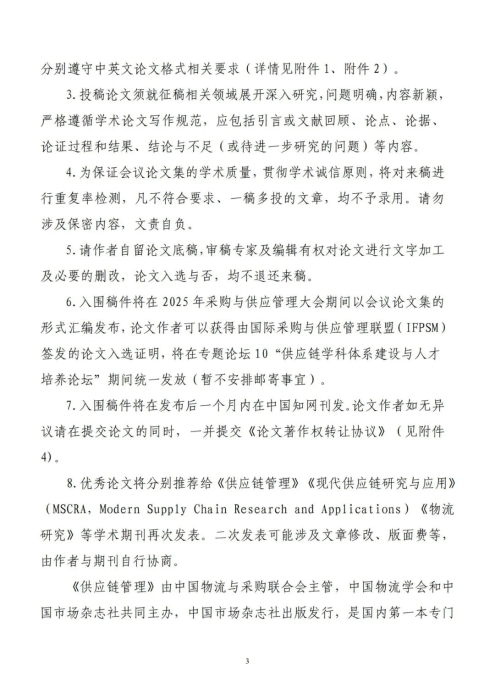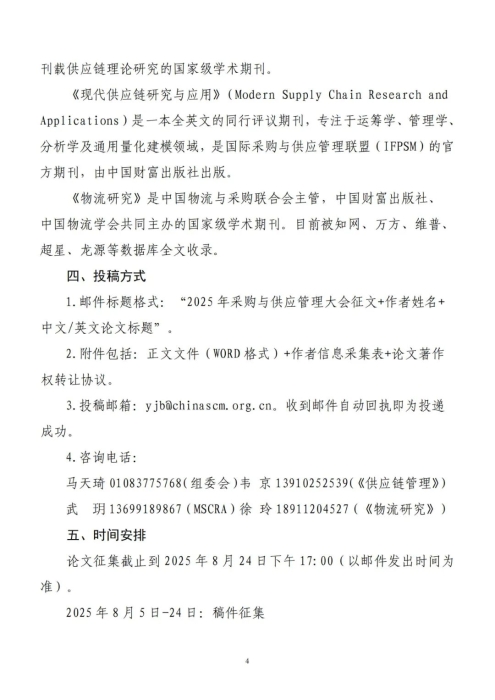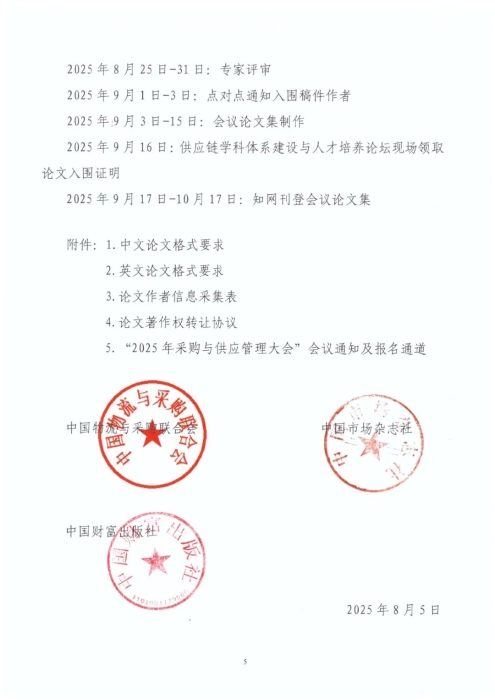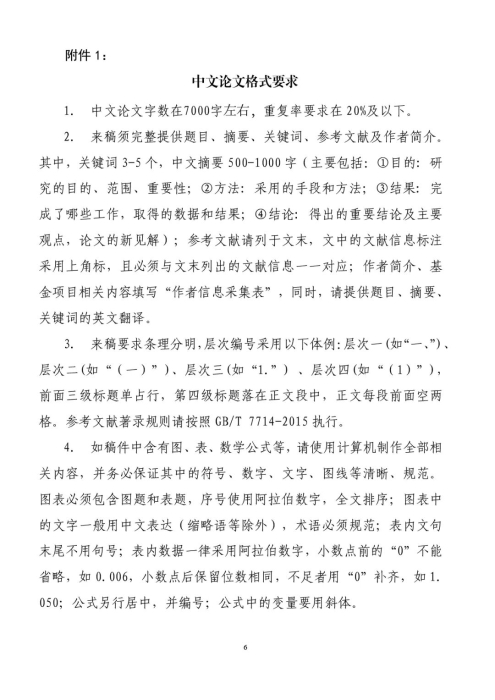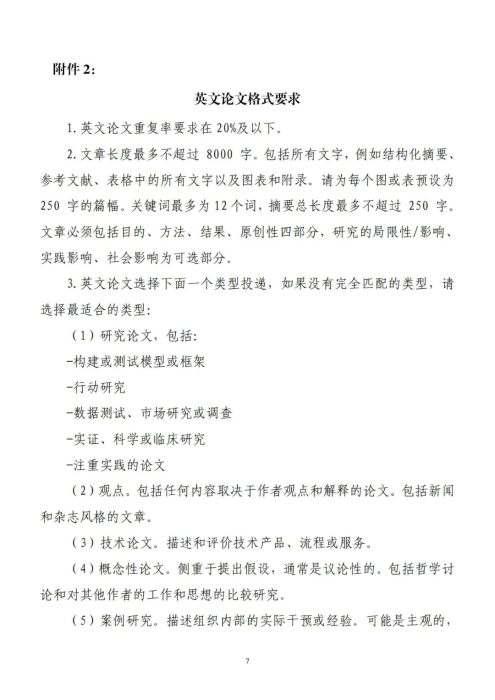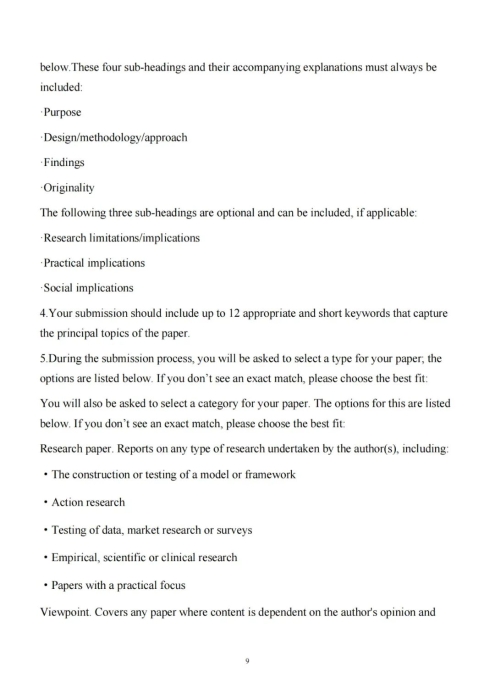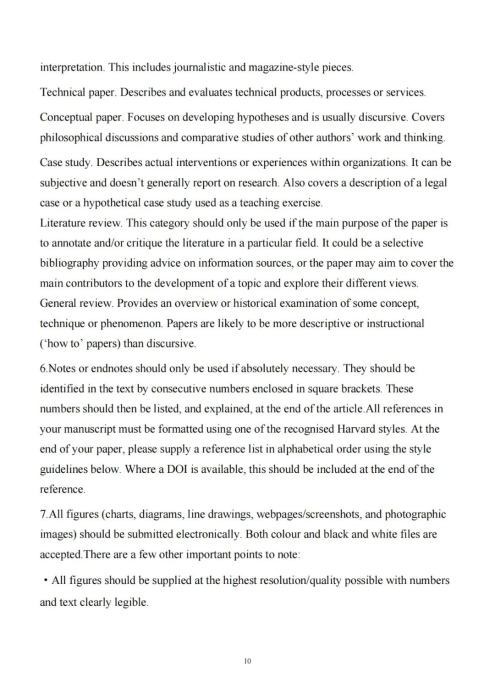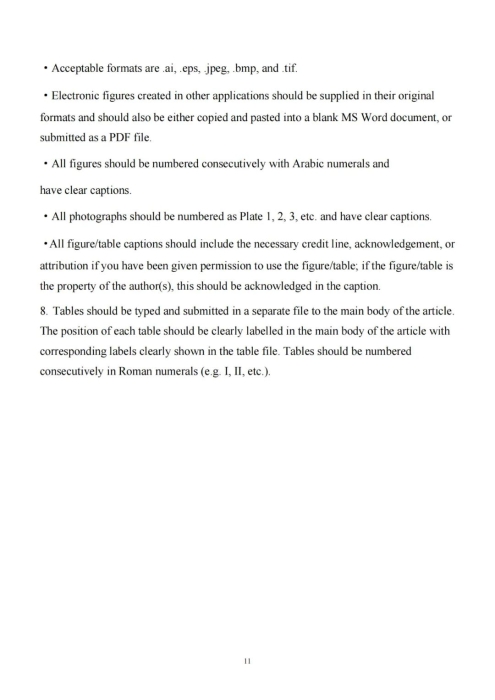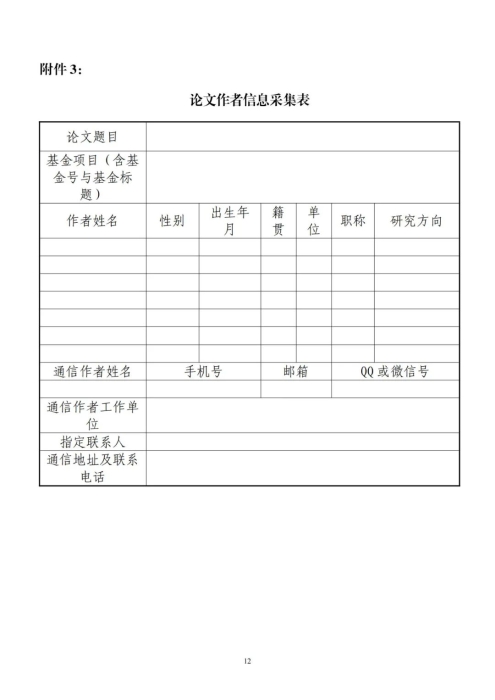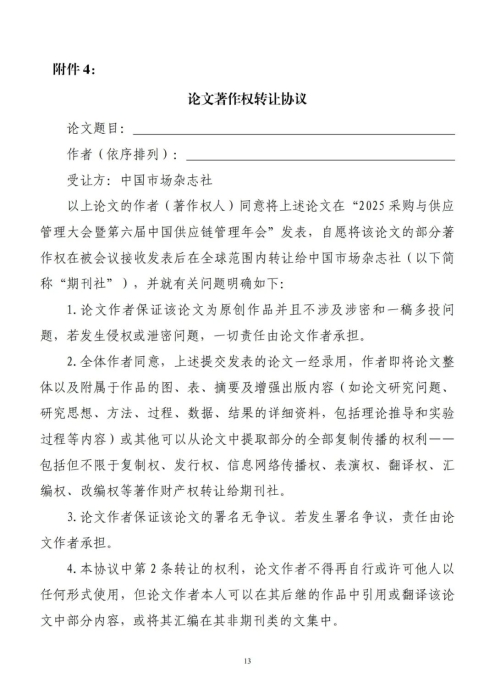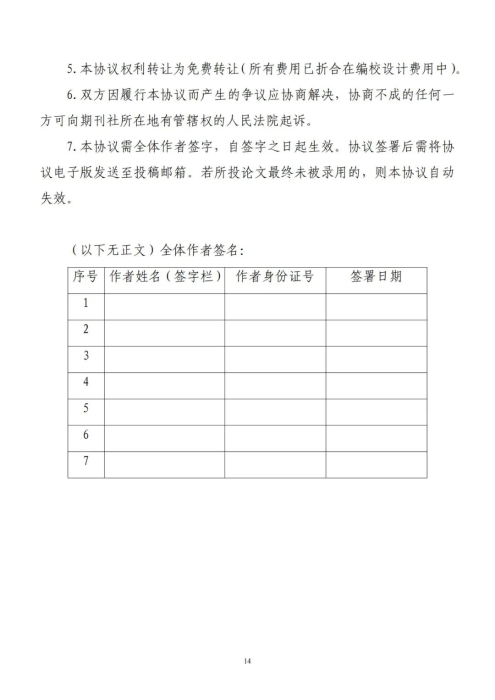 发布时间:2025年08月13日10:13
中物联采购与供应链专业委员会
发布时间:2025年08月13日10:13
中物联采购与供应链专业委员会
 关注中物联
关注中物联
各有关单位、各位专家、学者、业界同仁:
国际采购与供应管理联盟(IFPSM)世界大会,作为全球采购与供应链管理领域最具权威性和影响力的国际盛会,自1977年首届在意大利威尼斯举办以来,始终走在行业发展的最前沿。经中国物流与采购联合会与厦门市联合申办,国际采购与供应管理联盟同意2025世界大会(以下简称“2025年采购与供应管理大会”)于2025年9月14日—16日在中国厦门市举办,本次大会以“链接世界,合作共赢,共同建设开放包容韧性可持续的全球供应链”为主题,探讨国际供应链发展的新形势、新机遇、新挑战。
现面向国内外有关研究人员公开征集会议论文,欢迎踊跃投稿。
指导单位:
国际采购与供应管理联盟(IFPSM)
主办单位:
中国物流与采购联合会
承办单位:
中物联采购与供应链管理专业委员会
中国市场杂志社
中国财富出版社
本次征文聚焦采购、供应链及相关领域,投稿范围包括但不限于以下方向:
1.产业链供应链宏观经济政策研究
2.供应链管理体制机制创新实践经验
3.新技术、新装备在采购供应链领域的应用实践
4.供应链管理新模式、新理念效果总结
5.“双循环”新发展格局下的供应链创新
6.数智化转型对采购供应链的赋能与挑战
7.绿色低碳转型下的供应链重构
8.区域供应链生态与跨区域协同效率提升相关研究
9.供应链出海与全球供应链融合研究
10.构建韧性供应链、提升供应链安全相关研究
11.供应链标准化体系建设相关研究
12.精益供应链提质增效相关研究
1.会议论文征集不收取任何费用。
2.投稿论文接受中英文双语,均须为未公开发表的原创研究成果,分别遵守中英文论文格式相关要求(详情见附件1、附件2)。
3.投稿论文须就征稿相关领域展开深入研究,问题明确,内容新颖,严格遵循学术论文写作规范,应包括引言或文献回顾、论点、论据、论证过程和结果、结论与不足(或待进一步研究的问题)等内容。
4.为保证会议论文集的学术质量,贯彻学术诚信原则,将对来稿进行重复率检测,凡不符合要求、一稿多投的文章,均不予录用。请勿涉及保密内容,文责自负。
5.请作者自留论文底稿,审稿专家及编辑有权对论文进行文字加工及必要的删改,论文入选与否,均不退还来稿。
6.入围稿件将在2025年采购与供应管理大会期间以会议论文集的形式汇编发布,论文作者可以获得由国际采购与供应管理联盟(IFPSM)签发的论文入选证明,将在专题论坛10“供应链学科体系建设与人才培养论坛”期间统一发放(暂不安排邮寄事宜)。
7.入围稿件将在发布后一个月内在中国知网刊发。论文作者如无异议请在提交论文的同时,一并提交《论文著作权转让协议》(见附件4)。
8.优秀论文将分别推荐给《供应链管理》《现代供应链研究与应用》(MSCRA,Modern Supply Chain Research and Applications)《物流研究》等学术期刊再次发表。二次发表可能涉及文章修改、版面费等,由作者与期刊自行协商。
《供应链管理》由中国物流与采购联合会主管,中国物流学会和中国市场杂志社共同主办,中国市场杂志社出版发行,是国内第一本专门刊载供应链理论研究的国家级学术期刊。
《现代供应链研究与应用》(Modern Supply Chain Research and Applications)是一本全英文的同行评议期刊,专注于运筹学、管理学、分析学及通用量化建模领域,是国际采购与供应管理联盟(IFPSM)的官方期刊,由中国财富出版社出版。
《物流研究》是中国物流与采购联合会主管,中国财富出版社、中国物流学会共同主办的国家级学术期刊。目前被知网、万方、维普、超星、龙源等数据库全文收录。
1.邮件标题格式:“2025年采购与供应管理大会征文+作者姓名+中文/英文论文标题”。
2.附件包括:正文文件(WORD格式)+作者信息采集表+论文著作权转让协议。
3.投稿邮箱:yjb@chinascm.org.cn。收到邮件自动回执即为投递成功。
4.咨询电话:
马天琦01083775768(组委会)
韦 京13910252539(《供应链管理》)
武 玥13699189867(MSCRA)
徐 玲18911204527(《物流研究》)
论文征集截止2025年8月24日17:00(以邮件发出时间为准)。
2025年8月5日—24日:
稿件征集
2025年8月25日—31日:
专家评审
2025年9月1日—3日:
点对点通知入围稿件作者
2025年9月3日—15日:
会议论文集制作
2025年9月16日:
供应链学科体系建设与人才培养论坛现场领取论文入围证明
2025年9月17日—10月17日:
知网刊登会议论文集
附件:
1.中文论文格式要求
2.英文论文格式要求
3.论文作者信息采集表
4.论文著作权转让协议
5.“2025年采购与供应管理大会”会议通知及报名通道
中国物流与采购联合会
中国市场杂志社
中国财富出版社
2025年8月5日
1.中文论文要求字数在7000字左右,重复率要求在20%及以下。
2.来稿须完整提供题目、摘要、关键词、参考文献及作者简介。其中,关键词3~5个,中文摘要500-1000字(主要包括:①目的: 研究的目的、范围、重要性;②方法: 采用的手段和方法;③结果: 完成了哪些工作,取得的数据和结果;④结论: 得出的重要结论及主要观点,论文的新见解);参考文献请列于文末,文中的文献信息标注采用上角标,且必须与文末列出的文献信息一一对应;作者简介、基金项目相关内容填写“作者信息采集表”,同时,请提供题目、摘要、关键词的英文翻译。
3.来稿要求条理分明,层次编号采用以下体例:层次一(如“一、”)、层次二(如“(一)”)、层次三(如“1.”) 、层次四(如“(1)”),前面三级标题单占行,第四级标题落在正文段中,正文每段前面空两格。参考文献著录规则请按照GB/T 7714-2015执行。
4.如稿件中含有图、表、数学公式等,请使用计算机制作全部相关内容,并务必保证其中的符号、数字、文字、图线等清晰、规范。图表必须包含图题和表题,序号使用阿拉伯数字,全文排序;图表中的文字一般用中文表达(缩略语等除外),术语必须规范;表内文句末尾不用句号;表内数据一律采用阿拉伯数字,小数点前的“0”不能省略,如0.006,小数点后保留位数相同,不足者用“0”补齐,如1.050;公式另行居中,并编号;公式中的变量要用斜体。
1.英文论文重复率要求在20%及以下。
2.文章长度最多不超过 8000 字。包括所有文字,例如结构化摘要、参考文献、表格中的所有文字以及图表和附录。请为每个图或表预设为 250 字的篇幅。关键词最多为12个词,摘要总长度最多不超过 250 字。文章必须包括目的、方法、结果、原创性四部分,研究的局限性/影响、实践影响、社会影响为可选部分。
3.英文论文选择下面一个类型投递,如果没有完全匹配的类型,请选择最适合的类型:
(1)研究论文,包括:
-构建或测试模型或框架
-行动研究
-数据测试、市场研究或调查
-实证、科学或临床研究
-注重实践的论文
(2)观点。包括任何内容取决于作者观点和解释的论文。包括新闻和杂志风格的文章。
(3)技术论文。描述和评价技术产品、流程或服务。
(4)概念性论文。侧重于提出假设,通常是议论性的。包括哲学讨论和对其他作者的工作和思想的比较研究。
(5)案例研究。描述组织内部的实际干预或经验。可能是主观的,一般不报告研究情况。也包括对法律案例的描述或作为教学练习的假设性案例研究。
(6)文献综述。只有当论文的主要目的是对某一领域的文献进行注释和/或评论时,才能使用这一类别。
(7)综述。对某些概念、技术或现象进行概述或历史考察。论文的描述性或指导性可能多于论述性。
4.所有数字均应以尽可能高的分辨率/质量提供,数字和文字应清晰可辨。图片可接受的格式有.ai、eps、jpeg、bmp和.tif.在其他应用程序中创建的电子图表应以原始格式提供,并应复制和粘贴到空白的MS Word文档中,或以PDF文件格式提交。所有数字均应使用阿拉伯数字连续编号,并有清晰的标题。所有照片应编号为Plate 1、2、3等,并有清晰的标题。表格应用罗马数字连续编号(如I、Ⅱ等)。如果您已获得使用该图/表的许可,则所有图/表的标题均应包括必要的署名、致谢或归属;如果该图/表属于作者的财产,则应在标题中予以注明。
5.所有参考文献使用哈佛参考文献方式标注在论文末尾。非必要请勿使用注释或尾注,如使用应在正文中用方括号括起来的连续数字标明。并在文章末尾列出这些编号并加以说明。
Manuscript requirements
1.The similarity index must not exceed 20%.
2.Articles should be up to a maximum of 8000 words in length. This includes all text, for example, the structured abstract, references, all text in tables, and figures and appendices.Please allow 250 words for each figure or table.
3.All submissions must include a structured abstract, following the format outlined below.These four sub-headings and their accompanying explanations must always be included:
·Purpose
·Design/methodology/approach
·Findings
·Originality
The following three sub-headings are optional and can be included, if applicable:
·Research limitations/implications
·Practical implications
·Social implications
4.Your submission should include up to 12 appropriate and short keywords that capture the principal topics of the paper.
5.During the submission process, you will be asked to select a type for your paper; the options are listed below. If you don’t see an exact match, please choose the best fit:
You will also be asked to select a category for your paper. The options for this are listed below. If you don’t see an exact match, please choose the best fit:
Research paper. Reports on any type of research undertaken by the author(s), including:
·The construction or testing of a model or framework
·Action research
·Testing of data, market research or surveys
·Empirical, scientific or clinical research
·Papers with a practical focus
Viewpoint. Covers any paper where content is dependent on the author's opinion and interpretation. This includes journalistic and magazine-style pieces.
Technical paper. Describes and evaluates technical products, processes or services.
Conceptual paper. Focuses on developing hypotheses and is usually discursive. Covers philosophical discussions and comparative studies of other authors’ work and thinking.
Case study. Describes actual interventions or experiences within organizations. It can be subjective and doesn’t generally report on research. Also covers a description of a legal case or a hypothetical case study used as a teaching exercise.
Literature review. This category should only be used if the main purpose of the paper is to annotate and/or critique the literature in a particular field. It could be a selective bibliography providing advice on information sources, or the paper may aim to cover the main contributors to the development of a topic and explore their different views.
General review. Provides an overview or historical examination of some concept, technique or phenomenon. Papers are likely to be more descriptive or instructional (‘how to’ papers) than discursive.
6.Notes or endnotes should only be used if absolutely necessary. They should be identified in the text by consecutive numbers enclosed in square brackets. These numbers should then be listed, and explained, at the end of the article.All references in your manuscript must be formatted using one of the recognised Harvard styles. At the end of your paper, please supply a reference list in alphabetical order using the style guidelines below. Where a DOI is available, this should be included at the end of the reference.
7.All figures (charts, diagrams, line drawings, webpages/screenshots, and photographic images) should be submitted electronically. Both colour and black and white files are accepted.There are a few other important points to note:
·All figures should be supplied at the highest resolution/quality possible with numbers and text clearly legible.
·Acceptable formats are .ai, .eps, .jpeg, .bmp, and .tif.
·Electronic figures created in other applications should be supplied in their original formats and should also be either copied and pasted into a blank MS Word document, or submitted as a PDF file.
·All figures should be numbered consecutively with Arabic numerals and
have clear captions.
·All photographs should be numbered as Plate 1, 2, 3, etc. and have clear captions.
·All figure/table captions should include the necessary credit line, acknowledgement, or attribution if you have been given permission to use the figure/table; if the figure/table is the property of the author(s), this should be acknowledged in the caption.
8.Tables should be typed and submitted in a separate file to the main body of the article. The position of each table should be clearly labelled in the main body of the article with corresponding labels clearly shown in the table file. Tables should be numbered consecutively in Roman numerals (e.g. I, II, etc.).
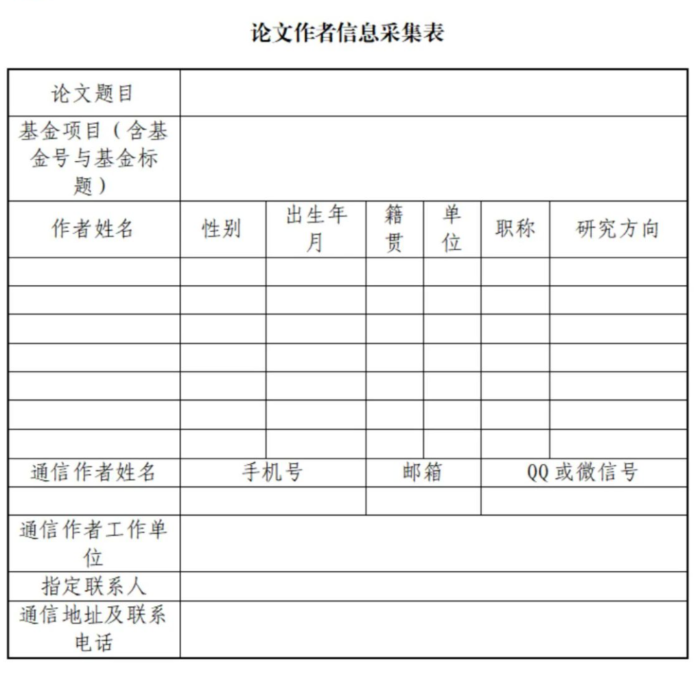
左右滑动查看更多
左右滑动查看更多
左右滑动查看更多
关于召开2025年采购与供应管理大会暨第六届中国供应链管理年会.pdf
 责任编辑:中物联采购与供应链专业委员会
责任编辑:中物联采购与供应链专业委员会

